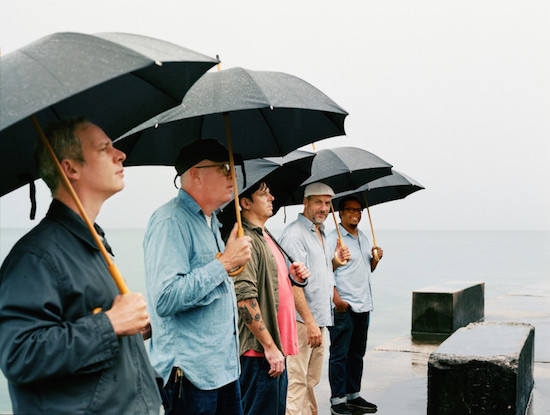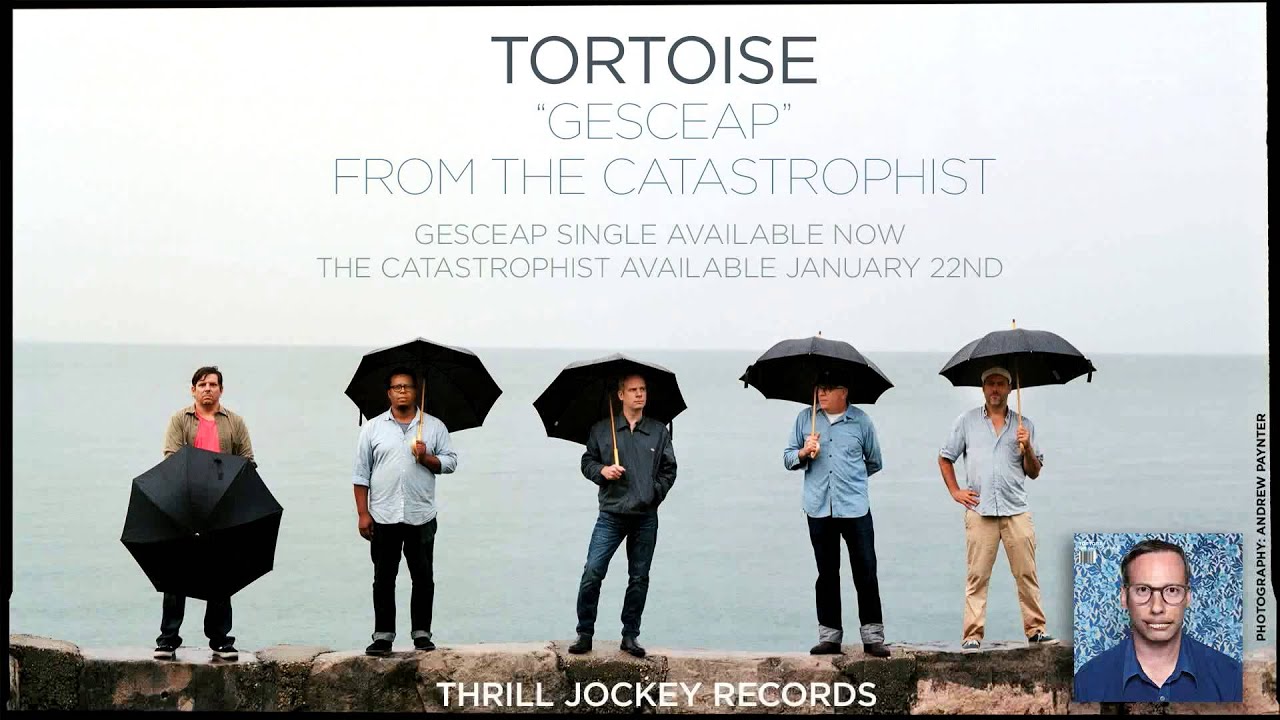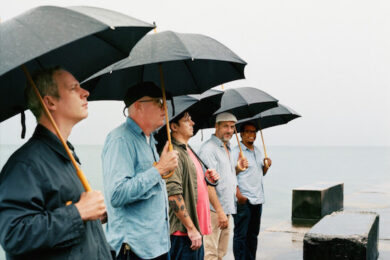As the late great Terry Pratchett said, “Everything starts somewhere, though many physicists disagree”. It is easy to forget that the now sprawling umbrella category of ‘post-rock’ meant nothing before Tortoise and their ilk introduced the nineties to the expansive potential of the genre.
By infusing their unpretenftious prog rock stylings with elements of jazz, dub, punk and Krautrock, the band invented a slow-burning form of instrumental music that, as it turned out, kickstarted the Wolverine of all musical genres: a movement that’s continued to be unkillable, unwavering and wryly reticent to this day. But, while many bands that manage to capture the public imagination in such a way tend to spawn a wave of superior imitators and then fade into obscurity, Tortoise have consistently produced solid albums with nary a dip in their quality of output over their 25-year career.
The latest addition to the band’s respectable corpus of work is the long gestating The Catastrophist. At this stage the band are veterans of the slow and steady album promotion schtick, so when I meet bassist Doug McCombs and drummer John Herndon (who are stopping off in London as they travel from their home city Chicago to the start of their European tour in Copenhagen) it’s a testament to their professionalism that they are still able to power through the jetlag and give me an insight into the method and madness by which they hammered their seventh album into shape.
How sure were you that there was going to be a follow-up album to 2009’s Beacons of Ancestorship?
John Herndon: Well it’s the same discussion we have after we complete every Tortoise record. We finished our tour, had a break and then talked about releasing a few EPs or something else like that. Then we waited another year and said to each other: ‘Well, maybe we should do that next record?’ Then we waited another nine months to actually get down to it.
Doug McCombs: The [commission from the City of Chicago to write a collection of music based around the city’s heritage] helped kickstart the album for sure. It takes us a long time to get to a place where we start to get somewhere. And by a ‘little while’ I mean around a year or so just recording ideas and throwing them away or not knowing what to do with them for ages.
How much did the City of Chicago commission feed into the end result?
JH: The themes are there but they’re well worked over from the original versions. The arrangements were tightened up so the five of us could approach it as Tortoise material. The original songs were written with soloists in mind so we’d play a melody, repeat the form and then loop the chord changes. If you were to hear a recording of the original material you could tell which song it was, but the final versions were sculpted with the Tortoise unit in mind. I’m sorry, I’m so jetlagged I’m using words like ‘sculpted’!
DM: It’s exactly right though, when we came up with those tunes it was for a live presentation that would feature all these guest musicians. There was an ensemble backing in mind but there would also be all this room to solo and engage the audience in that live manner. But the five of us don’t really do that, we’re not really interested in taking up guitar, synthesiser or vibraphone solos. So we tried to make them more about the vibe of the whole song without anything jumping out, instead making them interesting by flipping things around or trying new ideas. ‘Sculpting’ them.
You are often known to take ideas and motifs that you have performed many years earlier and turn them into fully fleshed-out songs on record. Which songs on The Catastrophist have had the longest gestation period?
DM: I think I know the answer to that question: it’s gotta be ‘Hot Coffee’ which is at least 10 years old, if not older. We were thinking about using it on Beacons of Ancestorship, but I’m pretty sure it was around even before that. I remember performing it live 10 years ago when you played those recorded electric eels, do you remember?
JH: (Uncertainly) Yes? Oh yeah! The recorded electric eel shocks. Man, I need to bring that back.
Have the extracurricular activities band members have pursued outside of Tortoise in recent years fed into the music on this album?
DM: Our other projects definitely fed in to Tortoise, but it’s not a one way door. The stuff that Tortoise does feeds back into all the other stuff we do too. It’s a cyclical situation. Sometimes these ideas we use are sourced from the compartmentalisation of the band. There are a lot of different directions we take as a unit and as combinations of the five of us. It builds our vocabulary together.
Did collaborations with the likes of Bonnie Prince Billy and other legendary singers inspire the decision to have not one but two vocal led tracks on this album in the form of the Georgia Hubley (Yo La Tengo) led ‘Yonder Blue’ and the David Essex cover ‘Rock On’ with Todd Rittmann?
JH: I think Doug and John were in the studio together smoking bongs and they came up with the idea of doing ‘Rock On’. We’d talked about having guest vocalists on a record pretty much since our debut, so it was an old idea that had bounced around enough by this point.
DM: And we’ve included singers on albums before. Back on Millions Now Living Will Never Die we worked with Mary Hansen and Laetitia Sadier but their voices aren’t really unrecognisable.
JH: Kelly Hogan was on ‘It’s All Around You’. There are no words but she sings on the song ‘The Lithium Stiffs’. Being a strictly instrumental band has never been a strict rule, I guess we just never came up with an idea for a song with vocals that held any weight until this record.
DM: The interesting thing is that we realised that it was way easier than making an instrumental record! The [David Essex cover] was already written which makes it doubly easy of course, but when there’s a vocal line or something that you focus on in the song it means that all the instrumental stuff doesn’t have to be concentrated upon quite so much. It’s something that took us 20 years to learn.
How was it you knew Todd and Georgia?
DM: Guest musicians on any Tortoise album are almost always friends or people we know. As a band I think we feel that if we’re going to outsource any musicianship or singing we want it to be someone that we’re friends with. I’ve known Todd for 15 years and Georgia for 30. At that song, ‘Yonder Blue’, it just sounded like a Yo La Tengo song and was made for her voice. Or at least that’s how it sounded to me, I don’t know about anyone else.
How did the songs on The Catastrophist come together? Did they start life as jams and move to a very different place as time progressed?
JH: There’s not much improvisation in the process at all, we just write compositions.
DM: We mostly write songs as a group when we’re actually in the studio, bouncing ideas off eachother and then we kind of layer this stuff and strip stuff away from it. Occasionally around a third or a quarter of the time someone will have a more composed idea they bring in that we’ll hash out as a group. But yeah, we don’t sit in the practice space and jam.
The Catastrophist has no epically long compositions to match ‘DJed’ or ‘High Class Slim Came Floating In’. Was this a conscious decision and does it mean that this album might be the most immediate and apt album to introduce a friend to the sound of Tortoise with?
DM: It’s just the way it turned out. I mean, it’s an odd coincidence that there are two songs with vocals on the record and that most of the songs are pretty succinct. Would this be a good gateway drug album for someone getting into Tortoise? I guess if you’re not into long songs! These are some of the shortest songs that we’ve ever done.
Where do the song titles come from?
DM: A lot of the time the only person who knows what a song title means is the person who came up with it. Also we compile a list of song titles that each of us had had and try to decide which one makes the most sense with which song. One of mine was ‘The Clearing Fills’.
JH: I think my only contribution was ‘The Catastrophist’, so I win.
Tortoise’s new album The Catastrophist is out now on Thrill Jockey




